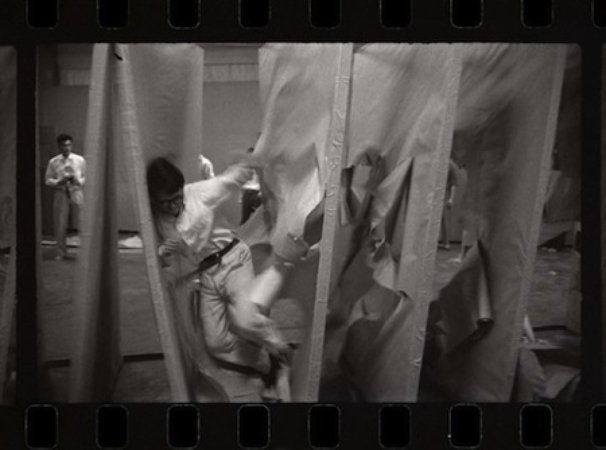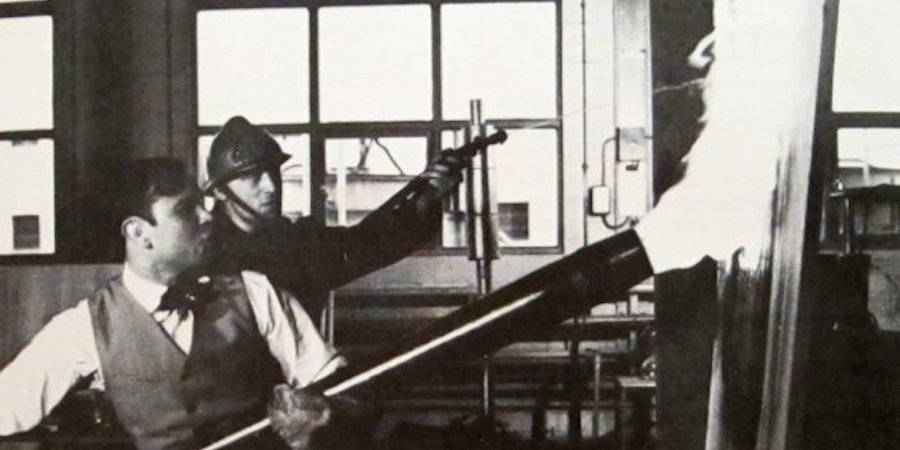Since the dawn of the avant-garde, artists have striven to challenge the boundaries set by conventional painting—the traditional use of oil, acrylic, tempura, and other mediums designated by the Academy as appropriate for dignified employment on canvas. Modern art, especially, unleashed an onslaught of new and unusual art processes, beginning with the Cubists' magpie use of collage and texture-rich materials like sand and sawdust. This restless sense of innovation and nonconformity has continued apace since, leading artists to concoct increasingly unusual—and sometimes violent—ways of engaging with their canvases.
Recently, Walter Robinson has introduced us to "Zombie Formalism," the aesthetic habit of contemporary artists to try a bit too hard to challenge what has been done before, creating what he calls “artificial milestones.” But through irreverent experimentation over the past half century, artists have achieved some more estimable milestones in terms of charting new possibilities of interacting with canvas. Here we look back on a few of the more attention-grabbing approaches—many of them associated with such intertwining art movements as NUL, ZERO, and Nouveau Réalisme—that range from peeing on a painting to beating the living daylights out of one.
BURNED, SINGED, ENFLAMED
PERPETRATOR: Yves Klein
WHAT HAPPENED: Yves Klein is best known for his monochromatic Blue paintings, for which he smothered canvases in his patented cobalt-like hue of International Klein Blue. Each was uniformly colored, but the paint was applied differently each time; he used rollers, sponges, and, famously, dragged naked female models across canvases, using their bodies as paint applicators. In another approach, he once attached canvases to the roof of his car and drove in the rain at 70 miles per hour so that they could record the splattering of raindrops at high speed. A year before he died in 1962 (at the premature age of 34), Klein turned to a new but equally unusual treatment of the canvas, using gas burners with flames nine to 12 feet high to scorch the cloth, creating patterns out of the soot.
PLACE IN ART HISTORY: Klein was hardly the only artist to play with fire, and round the same time, in 1959, Otto Piene created a series where he applied torches through a grid onto a canvas covered with a layer of solvent on pigmented paper, which yielded designs in ash. Dutch artist Henk Peeters—in a nod to Klein—created a series of Pyrographies, where he singed a sheet of monochromatic plastic stretched across a frame. The shared use of fire is no surprise considering that both Piene and Peeters were involved in the NUL and ZERO movements, which were closely related offsprings of Nouveau Réalisme movement, of which Klein was a member.
SHOT
PERPETRATOR(S): Nikki de Saint Phalle was the mastermind behind her Shooting Paintings, but friends like Robert Rauschenberg, Jasper Johns, and Jean Tinguely often joined in to take turns with the rifle.
WHAT HAPPENED: Beginning in the early 1960s, French artist Niki de Saint Phalle would create a canvas of sorts by placing glass bottles filled with paint on a wooden baseboard and covering them with plaster—and then she would shoot it with a .22 caliber rifle. Each time she released a bullet, penetrating the vessels beneath the surface, haphazard streaks of paint would release and drip down the canvas. She shot at life-sized plaster reliefs of male bodies, of mothers giving birth, of brides, of altars, of hearts, and of cathedrals. Originally partly inspired by Jackson Pollock's drips, this method became a sort of addiction for de Saint Phalle; for her, aiming a gun at a painting became an instantaneous release of her inner violence and anger—at her father, her conservative family values, and male-dominated society—and she was consumed by the process. She stopped in 1963, only two years after she began the series, because of her self-proclaimed addiction to shooting. Years later, in 2002, she died of emphysema, possibly as a consequence of inhaling paint fumes released by her bullets.
PLACE IN ART HISTORY: Though unintentionally, Warhol created a piece entitled The Shot Marilyns. These four multicolored silk-screen paintings of the famed Warhol muse were at first indistinguishable from the other paintings in the Marilyn series. Then one day, Dorothy Podber, a feminist Dada artist, stopped by the Factory, and asked to shoot one of his paintings. Believing she meant she wanted to photograph them, Warhol said okay, and Podber shot all four paintings of Marilyn directly in the forehead. She was never allowed in the Factory again.
STOMPED ON, BURST THROUGH, DANCED UPON
PERPETRATORS: Saburo Murakami, Kazuo Shiraga
WHAT HAPPENED: The Gutai group was a postwar Japanese radical art movement built around a core tenet: the process of damaging an object exposes its “inner life,” and therefore the act of destruction is one of beauty. Members Saburo Murakami and Kazuo Shiraga, who once formed the Japanese prong of the Dutch ZERO movement, responded by taking a dramatically physical approach to painting. For his Laceration of Paper series, Murakami would fling his body through a thin canvas, tearing the paper, and leaving a human-size hole behind. Shiraga would dip his feet in paint, and then delicately sweep them across the canvas, which was laid down on the floor.
PLACE IN ART HISTORY: For each respective artist’s process, performance—i.e. the spectacle of jumping through a canvas or majestically moving one’s body across the surface—was integral. Artists gathered to watch as Murakami and Shiraga created their works. Their unique processes influenced performance art and happenings of the '60s and '70s, and their Gutai counterparts—who vaguely introduced idea of the installation—inspired Fluxus mainstays like Allen Kaprow and Jim Dine, who in a 1960 performance called The Smiling Workman poured red paint on himself, drank it (actually it was tomato juice), and jumped through his canvas.
PUNCHED
PERPETRATOR: Ushio Shinohara
WHAT HAPPENED: You may recognize Shinohara from the 2013 documentary Cutie and the Boxer, a film that, much to the artist’s surprise, focuses more on his marriage and his wife Norikio’s charming cartoon-like drawings than his own art. Since the '60s Ushio has created “boxing paintings,” in which he tapes sponges to his boxing gloves, dips them in paint or sumo ink, and then punches enormous canvases. He may be one of the least successful well-known artists (the documentary reveals the couple’s struggle to pay their climbing rent in Dumbo, despite having exhibited in some of the most prominent international art institutions), but that has not stopped him from treating the canvas like a punching bag.
PLACE IN ART HISTORY: Shinohara conspired with the Neo-Dada Organizers, a postwar Japanese avant-garde group like the Gutai Group, only a generation younger and on a mission to create even more radical art. (The Japanese Neo-Dada found that the Gutai had grown too soft for their taste under the influence of Action Painting.)
URINATED UPON
PERPETRATOR(S): Andy Warhol, together with Factory regulars including Victor Hugo and Ronnie Cutrone, Warhol’s studio assistants. Electric violinist Walter Steding also contributed his pee to this greater artistic cause.
WHAT HAPPENED: In the late '70s, Warhol ventured from his repertoire of silk screens of illustrious faces and took an unexpected turn towards abstraction. However, the Pop Art virtuoso did not simply borrow a page from the skill set of the Abstract Expressionists that dominated the art scene early on in his career—though his foray into abstractionism reveals that he was admittedly intrigued by the movement. Instead, Warhol satirized the macho, gestural AbEX milieu by creating his Oxidation series with the male-est implements at hand, inviting friends and colleagues to urinate on a canvas covered with metallic copper pigments that would oxidize once the uric acid hit the surface. The result yielded surprisingly beautiful compositions of luminous golds and coppery hues.
PLACE IN ART HISTORY: Many artists from the Viennese Actionists to the photographer Andres Serrano have used bodily fluids like urine in their art—it’s so obviously provocative that one could call it a conventional choice of an alternate art process. What's interesting here, though, is what drove Warhol to do such a thing. Bob Colacello, a longtime member of the Factory and author of the Warhol biography Holy Terror, claimed that the artist told him he was inspired by Pollock, who was rumored to have pissed on a canvas before handing it to a client with whom he wasn't particularly smitten.
SLASHED
PERPETRATOR: Lucio Fontana
WHAT HAPPENED: Beginning in 1947, Fontana penned a mere five manifestos delineating his theories on Spatialism, essentially putting forth that abstraction was the future of contemporary art—specifically a form of abstraction that implemented novel and technologically progressive techniques. His Spacial Concept series shadowed his string of manifestos in both time and matter. Fontana punctured monochrome canvases, whose reverse side was often lined with a black gauze, either poking holes into the fabric or knifing aggressive slashes that resembled a shark’s lethal bite. Slightly revealing the darkness hidden beneath the canvas, these works—now hotly coveted at auction—toy with our concept of depth.
PLACE IN ART HISTORY: Fontana’s visionary concept of space surpassed the boundary of visual art and influenced non-visual artists, like the revered Brazilian architect Oscar Niemeyer (Fontana himself had trained as an architect) and the American composer John Cage.
AFFIXED WITH TRASH
PERPETRATOR: Robert Rauschenberg
WHAT HAPPENED: In the mid-'50s Rauschenberg one-upped the Cubists by invented a new sort of 3-D collage, incorporating a slew of found objects—chairs, scarves, bedposts, shirts, trash, and taxidermic animals, things he’d find laying on the street—into his canvas. Dubbed Combines due to this process’s ambiguous nature—was it sculpture or painting?—Rauschenberg’s pieces are an amalgamation of blotches of paint, newspaper clippings, photographs, and a variety of miscellaneous objects that together form associative fugues of elusive meaning. The basis remains the traditional canvas, though it may be hidden beneath the greater hodgepodge.
PLACE IN ART HISTORY: Though known for his abstract and minimalist paintings and sculptures, Frank Stella created a series of combine paintings in his own geometric style. They're mounted on the wall, with multicolored abstract structures and forms jet out into space from the foundation of the canvas. The materials may not be miscellaneous and everyday, as with Rauschenberg, but Stella’s renditions very much play with the ambiguity between panting and sculpture, flatness and three-dimensionality.
AUTO-DESTRUCTED
PERPETRATOR: Gustav Metzger
WHAT HAPPENED: In the 1960s, Metzger coined the idea of "auto-destructive art" in two manifestos in which he emphasized society’s reliance on and obsession with man-made or machine-made objects. These commodities would eventually degrade into nothing, he said, and he wanted to create art that conveyed this idea while simultaneously making an anti-capitalist and anti-consumerist statement, in key with the revolutionary spirit of the decade. His solution? To dabble with acid (hydrochloric, not the hallucinatory drug popular in this time). At a performance at the Tate in 1960, he stretched a piece of white Nylon across a glass plane and stood behind it, dipped a brush in the acid, and then painted it onto the sheet, which would immediately dissolve—or auto-destruct—to reveal the artist’s face through the glass. Metzger framed his performance as a protest against capitalism, consumerism, and nuclear warfare.
PLACE IN ART HISTORY: Many, many other artists have toyed with the idea of self-destruction in their work, from Jean Tinguely—whose legendary 1960 Homage à New York was a machine sculpture whose blades shredded itself into pieces—to Dieter Roth, whose ephemeral artworks include a sculpture out of birdseed and chocolate that he placed outside a garden to be ravaged by hungry birds.



























